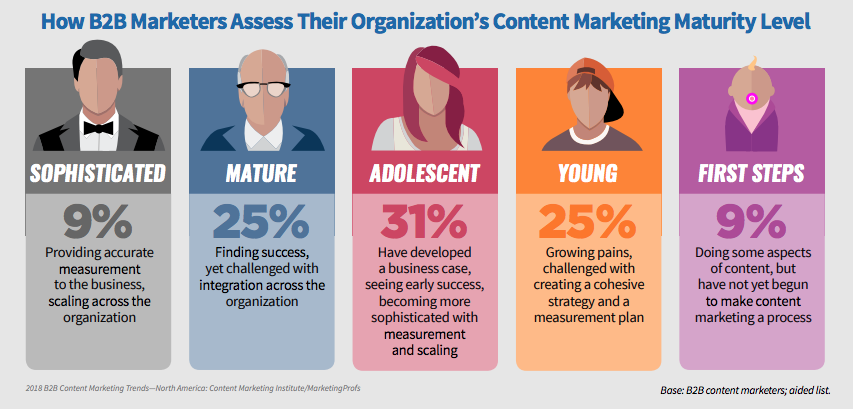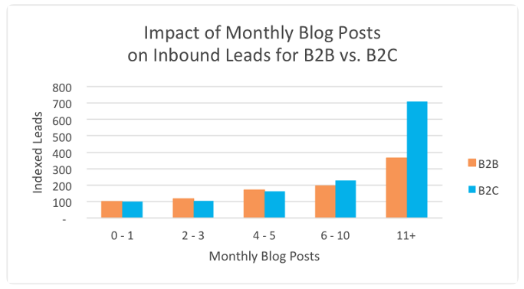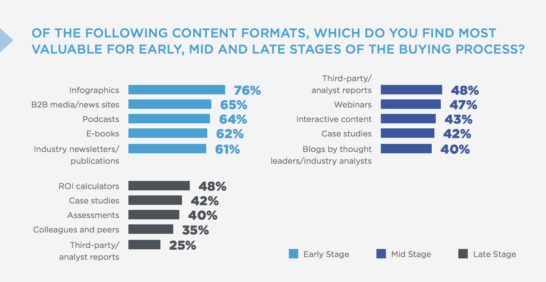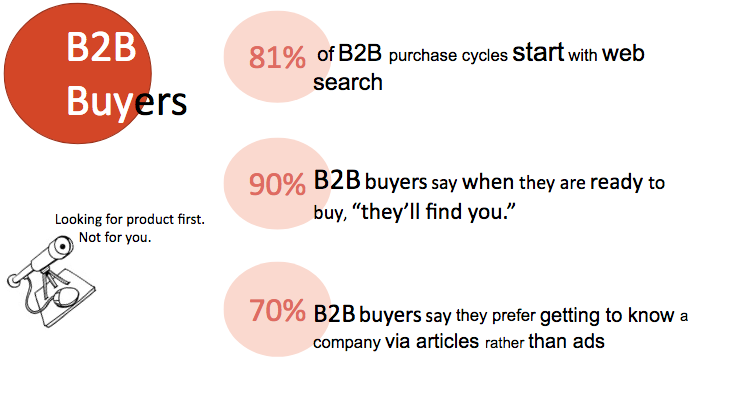As a B2B company, you need to learn how to properly market your brand to the right audience.
That’s because your target market doesn’t consume content the same way as the average consumer does. Following the habits and trends of a typical consumer won’t help you.
This is especially important for businesses operating as B2B as well as B2C companies. You need to be able to segment your content for each audience.
If your company is strictly a B2B operation, the content creation process should be even easier for you. You won’t have to worry about consumer content at all.
But regardless of your situation, to do this effectively, you need to understand how B2B audiences engage with content.
Then, you can adjust your B2B marketing strategy accordingly to reach these people.
The majority of B2B marketers believe that their content marketing strategy is still in the early stages.

Further, 91% of B2B companies use content marketing to promote their brands and reach their audiences.
But as you can see from the metrics above, the maturity levels of their marketing efforts are all over the board. Unless you’re in that top 9% who believe their strategies are sophisticated, it’s safe to say you could use some improvement.
That’s why I created this guide.
I’ll tell you exactly how B2B audiences engage with content. Then you can take this information to tailor your content strategy accordingly.
As a result, you’ll be able to generate more leads for your B2B company. Here’s what you need to know.
Focus on technology advancements
Your company needs to create business content that’s related to technology.
The best way to approach this is by discussing and showcasing new technological advancements your company has to offer.
Whether it’s new software, hardware, or other equipment, you’ll be able to offer exactly what your audience is looking for.
In fact, research shows that technology is the most popular business topic consumed by B2B audiences online.

This makes sense. Just think about it.
What is your B2B audience trying to accomplish?
Just like you, they want to improve their businesses. They’ll be researching the latest and greatest technology.
Even if your company hasn’t released new technology, you can still create content on the subject. Discuss industry updates and other advancements you’re anticipating.
Maybe you are developing something. You don’t need to wait until it’s released to share that information.
Learn how to build hype for a new product launch before the release.
Blog content
You know you need to create content focusing on new technology. But how do you distribute it?
You need to put lots of effort into your blogging strategy.
We know that 76% of B2B marketers publish blog posts. And 73% publish case studies.
You should do the same or risk falling behind your competitors. B2B marketing is a competitive field. Once a client builds a relationship with another company, it could be difficult for you to get their business.
But running a credible, informative, and resourceful blog will give you an edge.
That’s because 96% of B2B buyers say they want to consume content from industry leaders.
You can become that industry leader. Just make sure you publish content frequently to establish credibility. This will make it easier for you to get your target audience to engage with your content.
Plus, blogging is one of the best types of content that gets your audience into the conversion funnel.

If they’re reading your blog, it means they are on your website.
And that means they are more likely to convert, especially if you offer them actionable content.
After all, you’ve become an industry leader. The people reading your blog will be more inclined to use your products and services.
Furthermore, the publishing frequency of blog posts has a direct impact on website traffic.
This statement holds true for both B2B and B2C companies.

Simply put, the more blog posts you publish, the more inbound leads you’ll get.
Blogging will help improve your SEO strategy, which will result in expanding your reach through organic traffic.
Infographics
Right now, your content might be good. But who wants to be good? That just isn’t enough.
You need to find ways to make your content great. Figure out how to stand out and speak to your B2B audience in ways they understand.
Learn how to enhance your content by building infographics.
Your brain processes images 60,000 times faster than words alone. Plus, 90% of information transmitted to your brain is visual. And 65% of people are visual learners.
That’s why infographics are so powerful, especially for B2B audiences.

As you can see from this data, 76% of B2B buyers said that infographics were a valuable part of the buying process.
This ranked higher than any other type of content from each buying stage.
As a B2B marketer, you need to create infographics to cater to your audience’s needs.
This can work in conjunction with your blogging strategy, discussed previously.
To make your posts more appealing, add custom infographics to them. As you can see from reading my content, I use images, graphs, and infographics in my blog posts all the time.
I believe in this strategy, and you should as well if you want to reach your B2B target market effectively.
Make it easy to find solutions
Your B2B company needs to offer solutions to your target audience.
For example, let’s say you manufacture goods. Once an order is placed, you promise to ship within three business days.
That could be the differentiating factor giving you a competitive edge over companies that may not ship for two weeks.
If a prospective B2B client is searching for a manufacturer that can deliver goods faster than their current supplier, your company would be a viable option.
However, you won’t be able to acquire these customers if it’s too difficult for them to find solutions on your website.
Keep these questions in mind when you’re designing your site:

Prospective clients need to find solutions to their problems. If you can create content that shows your qualifications, they’ll be more likely to use your services.
In addition to displaying information properly on your website, you need to take this strategy to the next level.
Share content on social media, which I’ll discuss in greater detail shortly.
You also need to offer excellent customer service. Make it easy for people to contact you online, over the phone, through email, or potentially in person.
Consider implementing live chat to provide better customer service as well.
This will make it much easier for your audience to find solutions when they’re consuming your content.
Social media
As I just said, you need to market your company through distribution channels outside of your website. Social media is a must.
Your B2B audience is active on social media.
Just like you, they probably have profiles on these platforms to promote their own businesses as well.
But they don’t consume content the same way as B2C consumers do. You can’t expect them to scroll mindlessly through Instagram to engage with business-related content.
Instead, B2B marketers have greater success on other platforms.

LinkedIn, Twitter, and YouTube are the three most popular platforms for consuming B2B content online.
Your company needs to have an active presence on all three of these if you want to be successful.
Am I saying you don’t need Facebook? Absolutely not.
You should definitely have a Facebook page for your B2B company. It just shouldn’t take priority over your LinkedIn strategy.
Don’t waste your marketing dollars on Facebook ads that won’t get seen by your audience.
Know your audience’s business hours
If you’re going to use social media to attract B2B audiences, which you should, you need to understand when these people are active.
Post content during the hours when they’re online. This is different from targeting a B2C audience.
As a business owner, your company is on your mind 24/7. But that’s not always the case with your B2B audiences.
Your audience may not necessarily be other business owners. The people who have the buying power for other businesses could be managers or employees who get paid hourly or receive a salary.
When they go home after work, they aren’t thinking about their jobs.
Don’t share content on a Saturday afternoon when these people are not at work. They don’t consume business-related content when they’re not on the clock.
Email communication
Email marketing is another effective way to reach your B2B target market.
In one day, the average office worker receives 121 emails. Your content needs to be impressive to stand out from the other hundred messages in their inbox.
Otherwise, your message could go straight to the trash folder.
Although office workers get many emails, 77% of B2B consumers still say they prefer to have business communication through email.
That’s why B2B marketers name email as the most effective tactic for generating new leads.

Since you know this is how your audience is engaging with content, and it’s how they want to consume it, you need to focus on building quality email lists.
This will be different from a B2C email list building strategy.
When targeting consumers directly, you’ll have much larger email lists. Yes, obviously it’s better if those email addresses are qualified, but you won’t be as picky.
But with B2B email lists, qualified leads are an absolute necessity.
In addition to sending out newsletters and content, your B2B email strategy might require a bit more work.
You may want to consider sending individual messages to your current and prospective clients as opposed to using email software for mass distribution.
Depending on the size of your company, this won’t be unreasonable. Some of you may have only a dozen clients or so.
This strategy is unrealistic for B2C brands with thousands of subscribers on their email lists.
Prioritize organic search
I briefly mentioned SEO when I discussed your blogging strategy. But it’s worth talking about in greater detail.
If you want to successfully reach your B2B audience, your SEO strategy needs to be a priority.
Think about the way you personally consume content.
You are not only a B2B marketer but also a B2B consumer. Your habits should be similar to the habits of your target audience.
When you’re looking for information online, I bet you start with a Google search.

In fact, 81% of B2B purchases start with search.
As you can see, B2B audiences want to get to know companies from articles instead of paid ads. That’s why your blogging strategy is so important.
Not only will it help you with SEO, but it will also give your audience content they want to consume.
I’m not saying you shouldn’t pay for ads or run PPC campaigns. You can still generate leads from those.
But as you can see from those numbers above, organic traffic is more important.
Optimize content for mobile devices
One area where B2B audiences and B2C audiences have similarities is with the devices they use.
The days of business content being consumed only on desktop computers in the office are over.
Smartphones and tablets have penetrated the workplace.
Companies are getting more relaxed. They are not forcing their employees to sit in a cubicle for 40 hours a week.
With mobile devices, people can be productive on the go. They can work from homes, coffee shops, or even public transit.
People will work anywhere where they can be productive. If they finish their work for the day, they’ll be able to go home.
That’s probably why we’re seeing such a major growth in smartphone usage throughout the B2B buying process.

At the very least, your website needs to be optimized for mobile devices.
But you can take that strategy one step further. Your email content should be mobile-friendly as well.
Depending on the size of your company, you may even want to consider building a mobile app to reach your B2B target audience.
Industry trends
B2B audiences need to stay up to date with the latest industry news and trends.
In fact, 45% of B2B audiences read business content online to stay informed about industry trends.

You can become a resource for that information. Consider using this topic to your advantage with your blogging and email strategies.
Publish blog posts about what to expect in your industry.
Send out email newsletters with breaking news stories.
If you can master this strategy, you can become the primary resource of industry information for your target audience.
Conclusion
B2B audiences don’t consume content online the same way as B2C consumers do.
You need to recognize this and adjust your content strategy accordingly.
Publish content about technological advancements. Keep your audience informed on industry news and trends.
Establish yourself as a credible resource through your blogging strategy.
Enhance your content with infographics.
Build a quality email list. Personalize your messages.
Stay active on social media. Just make sure you’re prioritizing the right distribution channels.
Know the days and times when your B2B audience is consuming content.
Recognize the devices people are using to engage with content. Make sure your website is optimized for mobile searches.
Once you understand how your target audience consumes business content online, you’ll be able to improve your overall B2B marketing strategy.
from Quick Sprout https://ift.tt/2JLUlxQ
via IFTTT
